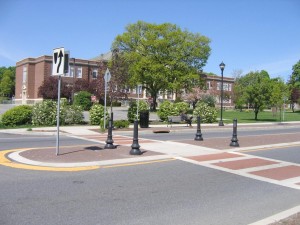A biweekly newsletter with public space news, resources, and opportunities.
A curated dispatch on all things public markets plus the latest announcements from the Market Cities Program.
Poughkeepsie, NY
4 → 2 Lane Configuration + Roundabouts and Pedestrian Infrastructure

Raymond Avenue borders Vassar College, residences, the Arlington Business District, open space, and an elementary school in the Town of Poughkeepsie. It is also known as Route 376, and was converted into a four lane minor arterial in the 1960s. This rightsizing project reconfigured 1.5 miles of Raymond Avenue to two lanes, calmed a previously unsafe corridor, and added a range of pedestrian and aesthetic improvements.
In 1999, Project for Public Spaces was hired by Vassar College and the Arlington Steering Committee to study the Arlington Business District. Recommendations for the area included traffic calming, which prompted a redesign of Raymond Avenue by the New York State Department of Transportation (NYS DOT). Phase I, which was completed in 2007, installed two roundabouts and a mid-block crossing on the southern portion of the street in front of Vassar College. Phase II included street landscaping and the installation of third roundabout that serves as a gateway to the business district. Several blocks of Raymond Avenue in the business district itself were also redesigned.
The project succeeded at improving the pedestrian experience and safety, increasing aesthetic appeal, and supporting a vibrant business district.

A study of the results of the Phase I redesign, which focused on the roadway in front of Vassar College, was undertaken prior to implementation of the Phase II redesign in the commercial district. These statistics refer to the outcomes of Phase I, utilizing data from May 2006 and May 2007, save for accident data, which compared alternate six month periods prior to and after Phase I’s installation because of time constraints. A full three-year before and after report is planned for 2013.

There was some discord, with the Arlington Business District and the NYS DOT (which controls Raymond Avenue) supporting the rightsizing, and the Town and City of Poughkeepsie formally opposing the changes. A neighborhood group on Grand Avenue was particularly upset by their road’s potential use as an alternate thoroughfare. After mitigation measures were installed, the city and residents appear happier with the project. Anecdotally, Raymond Avenue traffic volumes have recently risen to their previous levels. A study is planned for 2013 to evaluate road operations and safety for both phases together with a three year before and three year after period.
The rich text element allows you to create and format headings, paragraphs, blockquotes, images, and video all in one place instead of having to add and format them individually. Just double-click and easily create content.
The rich text element allows you to create and format headings, paragraphs, blockquotes, images, and video all in one place instead of having to add and format them individually. Just double-click and easily create content.
Body Text Body Link
The rich text element allows you to create and format headings, paragraphs, blockquotes, images, and video all in one place instead of having to add and format them individually. Just double-click and easily create content.
Here is some highlighted text from the article.




Headings, paragraphs, blockquotes, figures, images, and figure captions can all be styled after a class is added to the rich text element using the "When inside of" nested selector system.
Headings, paragraphs, blockquotes, figures, images, and figure captions can all be styled after a class is added to the rich text element using the "When inside of" nested selector system.
Headings, paragraphs, blockquotes, figures, images, and figure captions can all be styled after a class is added to the rich text element using the "When inside of" nested selector system.

We are committed to access to quality content that advances the placemaking cause—and your support makes that possible. If this article informed, inspired, or helped you, please consider making a quick donation. Every contribution helps!
Project for Public Spaces is a 501(c)(3) tax-exempt organization and your donation is tax-deductible within the guidelines of U.S. law.